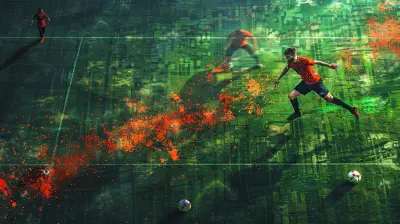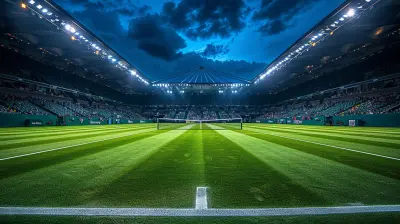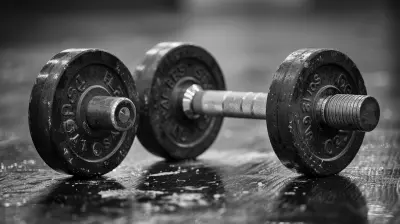Defensive Strategies for Shutting Down the Opposition
28 December 2024
In sports, many players and teams focus heavily on offense—the flashy goals, the last-second baskets, or the game-winning touchdowns. But here's something not many people talk about enough: defense. As the saying goes, "Offense wins games, but defense wins championships." And that couldn’t be more accurate.
No matter what sport you're playing—whether it's soccer, basketball, football, or hockey—developing a solid defensive strategy can be the difference-maker. After all, if you can't stop the opposition, you're going to have a tough time winning. So, how do you clamp down on your opponents and keep them from running up the score? Let's dive into the defensive strategies that can help you shut down the opposition and dominate the game.

Why Defense is So Important
Before we dive into the nitty-gritty of defensive strategies, let's take a moment to understand why defense is so crucial. Think of defense as the backbone of any team. No matter how talented your offense is, if your defense is porous, it’s like trying to fill a bucket with holes in it. You’ll score, sure, but the opposition will score just as easily—if not more.In high-stakes games, it often comes down to who can make that key stop, force a turnover, or lock down the opposing star player. Defense is about grit, discipline, and mental toughness. It doesn't have the same glamour as offense, but it's the foundation of a winning team.
1. Man-to-Man Defense
One of the most traditional forms of defense, especially in sports like basketball and football, is man-to-man defense. In this approach, each defender is responsible for guarding a specific player on the opposing team. The goal? Stick to that player like glue and make sure they can’t get an easy shot or play.How It Works
Man-to-man defense requires individual accountability. Every player must be aware of their assignment and focus on shutting down their man. This means following them closely, anticipating their moves, and denying them space. The key is to stay in front of your opponent and force them into tough situations—whether that’s a contested shot, a bad pass, or a turnover.When to Use It
Man-to-man is particularly effective when you have athletic, quick defenders who can match up well with the opposing team’s players. It works well against teams that rely on one or two superstars because your defenders can focus all their energy on neutralizing those key threats.Pitfalls to Avoid
The downside? If your defender gets beat off the dribble or loses their man, it can leave gaps in the defense. That’s why communication is crucial in a man-to-man setup. Teammates should be ready to help or switch if necessary.
2. Zone Defense
Zone defense is a strategy where each defender is responsible for a specific area of the field or court, rather than a specific player. This is common in basketball and football, but variations exist in soccer and hockey as well. The idea is to limit the opposition’s ability to penetrate and take high-percentage shots.How It Works
Instead of chasing individual players, defenders focus on guarding their assigned zones. The goal is to clog up the most dangerous areas, making it difficult for the offense to find open lanes or take uncontested shots. You’re essentially forcing the opposition into making mistakes by limiting their space.For example, in basketball, a 2-3 zone (two players at the top of the key and three near the baseline) can prevent easy drives to the basket and force the offense to settle for long-range shots.
When to Use It
Zone defenses are highly effective against teams that struggle with shooting from distance or rely heavily on dribble penetration. It’s also useful when your team is less athletic or undersized. By packing the defense into key areas, you can neutralize physical mismatches.Pitfalls to Avoid
The risk with zone defense is that it can leave open shots, especially from long-range. If the opposition has excellent shooters, they may be able to exploit the gaps in the zone. Additionally, zones can be vulnerable to offensive rebounds since defenders are guarding areas rather than boxing out specific players.
3. Press Defense
Ever heard of turning defense into offense? That’s where press defense comes in. This aggressive strategy is designed to pressure the opposition the moment they get possession, often forcing them into mistakes, turnovers, and bad decisions. Press defense is common in basketball and soccer but can be adapted to other sports as well.How It Works
In press defense, you apply immediate pressure on the ball handler, often before they’ve even crossed half-court (in basketball) or midfield (in soccer). The idea is to disrupt the flow of the offense and force them into hurried decisions. You’re not giving them time to set up plays or find their rhythm.For example, a full-court press in basketball involves pressuring the ball handler up and down the entire court, while a high press in soccer means pushing your forwards and midfielders up to challenge the opposing defenders as soon as they get the ball.
When to Use It
Press defense is most effective when you have fast, aggressive players who can maintain high energy throughout the game. It’s especially useful when you need to shift momentum, perhaps after a scoring run by the opposition or late in the game when you’re trying to make a comeback.Pitfalls to Avoid
The downside? Press defense is risky. If the opposition breaks the press, they can often get easy scoring opportunities on the other end. Pressing also requires a ton of stamina, so if your players get tired, the press can become less effective and leave you vulnerable.4. Switch Defense
Switching defenses is becoming increasingly popular in basketball, but it’s also used in sports like football and soccer. The idea behind switch defense is simple: when the offense sets a screen or pick, instead of fighting through it or going around, the defenders simply switch assignments.How It Works
When two offensive players set a screen or cross paths, the two defenders guarding them will "switch" and take on the other player. This prevents offensive players from getting open looks or mismatches, like a small guard getting stuck on a big forward.In basketball, for instance, if a guard sets a screen on a forward, the defending guard will switch onto the forward, and the defending forward will switch onto the guard. This keeps the defense balanced and doesn’t allow the offense to exploit mismatches.
When to Use It
Switching works best when your team is versatile and can defend multiple positions. If you have players who are capable of guarding different types of opponents—big or small—switching can be very effective. It’s also useful against teams that rely heavily on pick-and-roll plays or screens to create mismatches.Pitfalls to Avoid
Switching can lead to confusion if your team isn’t on the same page. If one defender switches and the other doesn’t, it can lead to wide-open shots or lanes to the basket. Communication is key to making switching work effectively.5. Double Team Defense
When one defender isn’t enough to stop a dominant player, the next step is to bring in a second defender. Double teaming is a strategy where two defenders focus on one offensive player, typically to trap them and force a turnover or take a bad shot.How It Works
The moment the offensive player receives the ball, two defenders collapse on them, cutting off their passing lanes and forcing them into a tough situation. The key here is timing—double teams work best when the offensive player is in a vulnerable position, like near the sideline or baseline, where they have limited options.In soccer, for instance, a defender might double team a winger who’s trying to dribble down the sideline. In basketball, double teaming a post player can prevent easy buckets in the paint.
When to Use It
Double teaming is effective when you're trying to neutralize a star player who’s dominating the game. It’s also useful in situations where the offensive player struggles under pressure or is prone to turnovers.Pitfalls to Avoid
The downside of double teaming is that it leaves another offensive player wide open. If the offense can pass out of the double team quickly, it can lead to easy scoring opportunities elsewhere. That’s why double teaming should be used strategically, not recklessly.6. Trap Defense
A subset of double teaming, trap defense is all about forcing turnovers by pinning the ball handler in a specific area. This strategy is commonly used in basketball and soccer, where the objective is to trap the offensive player against the sideline or corner, limiting their passing and movement options.How It Works
In a trap defense, two defenders converge on the ball handler, typically near the sideline or another boundary. By cutting off their ability to pass or move, the defenders can force a turnover, bad pass, or travel violation.Traps work best when the ball handler is in a confined space, like near the baseline in basketball or the corner flag in soccer. The defense essentially creates a "cage" around the offensive player, making it difficult for them to escape without making a mistake.
When to Use It
Trap defense is most effective against teams with weak ball handlers or when you need to create turnovers quickly. It’s also useful in late-game situations when you're trying to protect a lead or force the opposition into hurried decisions.Pitfalls to Avoid
Like double teaming, trap defense leaves gaps elsewhere on the field or court. If the trapped player can pass out of the trap effectively, it can lead to easy scoring opportunities for the other team. Timing and execution are crucial to making trapping work.Conclusion
Defense may not always be glamorous, but it’s the backbone of any successful team. Whether you're playing man-to-man, zone, press, or any other defensive strategy, the key is communication, effort, and discipline. When executed properly, a strong defense can stifle even the most potent offenses and turn the tide of a game in your favor. So, the next time you hit the court, field, or rink, remember: defense wins championships.all images in this post were generated using AI tools
Category:
Team SportsAuthor:

Preston Wilkins
Discussion
rate this article
19 comments
Rocco Rios
This article highlights essential defensive strategies, emphasizing adaptability and teamwork. Successfully shutting down opponents requires both individual skills and cohesive unit execution.
March 24, 2025 at 9:51 PM

Preston Wilkins
Thank you for your insight! I’m glad you found the focus on adaptability and teamwork essential for effective defense.
Audrey Hall
“Stay sharp, stay strong—defense wins games!”
March 15, 2025 at 9:59 PM

Preston Wilkins
Absolutely! A solid defense is key to dominating the game. Thanks for your support!
Zain McAdoo
This article brilliantly highlights key defensive strategies that can disrupt opponents' plays. Emphasizing communication, adaptability, and anticipation, it provides valuable insights for teams aiming to enhance their defensive game and achieve greater success on the field.
February 5, 2025 at 3:16 AM

Preston Wilkins
Thank you for your thoughtful feedback! I'm glad you found the insights on communication, adaptability, and anticipation valuable for enhancing defensive play.
Zara McClendon
Great insights on defensive strategies! The emphasis on teamwork and communication really highlights how crucial these elements are in shutting down the opposition. With the right execution, any team can elevate their game. Keep up the fantastic work, and best of luck on the field!
January 29, 2025 at 12:36 PM

Preston Wilkins
Thank you for your kind words! I'm glad you found the insights valuable. Teamwork and communication are indeed key to effective defense. Appreciate your support!
Nix Bowers
Effective defense often reflects a team's identity, shaping not just games, but their legacy.
January 26, 2025 at 3:20 AM

Preston Wilkins
Absolutely! A strong defense defines a team's character and can leave a lasting impact on its history and success.
Valen Shaffer
Defense wins games! Keep it tight and stay sharp, team!
January 20, 2025 at 12:39 PM

Preston Wilkins
Absolutely! A strong defense is key to success. Let's stay focused and execute our strategies!
Skye Gilbert
Great tips! With these strategies, defense can be a game-changer. Let's go!
January 16, 2025 at 1:25 PM

Preston Wilkins
Thank you! I'm glad you found the tips helpful—defense really does make a significant impact in the game! Let's implement these strategies!
Vex Myers
Great insights on defensive strategies! It's fascinating how adjustment and teamwork can completely alter a game's outcome. Looking forward to seeing these tactics in action this season. Keep up the good work!
January 13, 2025 at 1:46 PM

Preston Wilkins
Thank you! I'm glad you found the insights valuable. Excited to see how these strategies play out this season too!
Lincoln Stewart
Defensive strategies: because sometimes the best offense is a strong 'no'! Let’s keep those points on lockdown, team!" 🏐🔒
January 6, 2025 at 11:23 AM

Preston Wilkins
Absolutely! A solid 'no' can be a game-changer in maintaining control and focus. Let's fortify our defenses! 🛡️
Micah Mathews
Great article! It’s like a game of chess on the field—except the pawns are wearing shoulder pads! 🏈💪 Love the tips on defensive strategies. Remember, it’s not just about stopping them; it’s about making them wish they had stayed home! Keep up the fantastic work!
January 4, 2025 at 1:38 PM

Preston Wilkins
Thank you! I'm glad you enjoyed the article—great analogy! 🏈💪 Defensive strategies can really turn the game around!
Liv McVeigh
Great article! Love how you broke down those defensive strategies. It's inspiring to see how teamwork and smart tactics can completely shut down the opposition. Go team! Keep up the fantastic work!
January 3, 2025 at 7:54 PM

Preston Wilkins
Thank you for your kind words! I'm glad you found the breakdown of strategies helpful. Teamwork truly makes a difference!
Stacey Bell
This article effectively highlights key defensive strategies crucial for neutralizing opponents. Emphasizing adaptability, communication, and individual responsibility, it underscores the importance of systematic teamwork. Implementing these tactics can significantly enhance a team's defensive prowess and overall performance in high-stakes situations.
January 3, 2025 at 11:59 AM

Preston Wilkins
Thank you for your insightful comment! I’m glad the article resonated with you and highlighted the importance of teamwork and adaptability in defensive strategies.
Grayson Graham
What a fantastic read! Defensive strategies truly make or break a game, and your insights are spot on! It’s amazing how tactical plays can elevate the competition. Excited to see how teams implement these ideas. Here’s to thrilling games ahead and a defensive showdown that keeps us on the edge of our seats!
January 2, 2025 at 1:27 PM

Preston Wilkins
Thank you for your kind words! I'm thrilled you found the insights valuable. Here’s to many exciting defensive battles ahead!
Talis Hines
Effective defensive strategies focus on communication, positioning, and adapting quickly to opponents’ tactics.
January 1, 2025 at 8:42 PM

Preston Wilkins
Absolutely! Strong communication and quick adaptation are key to a successful defensive strategy.
Daniel McLemore
Intriguing insights on defensive strategies! I'm curious about how specific formations can adapt to different opponents. Do you think certain tactics are universally effective, or do they need to be tailored for each matchup? Looking forward to your thoughts!
January 1, 2025 at 1:22 PM

Preston Wilkins
Thank you for your comment! While some tactics can be universally effective, adapting formations to specific opponents is crucial for maximizing success. Each matchup presents unique challenges that require tailored strategies.
McMillen
Great insights! Effective defensive strategies can truly transform a team's performance. It's all about communication and teamwork on the field. Keep these tips in mind, and you'll see how they can shut down even the toughest opponents. Go team!
December 31, 2024 at 5:07 AM

Preston Wilkins
Thank you! I completely agree—strong communication and teamwork are key to executing effective defensive strategies. Let's keep pushing for success!
Rory McGinnis
Focus on teamwork and communication!
December 30, 2024 at 1:07 PM

Preston Wilkins
Absolutely! Effective teamwork and communication are crucial for successfully implementing defensive strategies.
Drake Porter
Or just bribe the ref—works every time, right?
December 28, 2024 at 10:02 PM

Preston Wilkins
While bribery might sound tempting, ethical strategies are always more effective in the long run!
Hudson Sanchez
Great insights on defensive strategies! Remember, a strong defense isn't just about blocking opponents—it's about teamwork, communication, and resilience. Every play is an opportunity to grow, adapt, and shine. Keep pushing forward, and let's dominate the game together!
December 28, 2024 at 3:31 AM

Preston Wilkins
Thank you! I completely agree—defense thrives on teamwork and adaptability. Together, we can elevate our game!
MORE POSTS

Analyzing the Impact of Substitutions in Crunch Time

The Role of Intuition in Sports: Trusting Your Instincts Under Pressure

How to Build a Balanced and Effective Push-Pull Workout Routine

New Rules in Tennis: What Players and Fans Should Expect

How to Improve Your Skating Speed and Agility on the Ice

From Competition to Compassion: Stories of True Sportsmanship

The Growing Importance of Mental Health in Professional Leagues

The Role of Mentorship in Fostering Sportsmanship Among Athletes

How Sports Leagues Drive Local Economies

The Connection Between Mental Focus and Physical Injury Recovery

Small Town, Big Dreams: Underdog Teams That Stole the Show

The Best Upper Body Exercises for Building Strength and Size